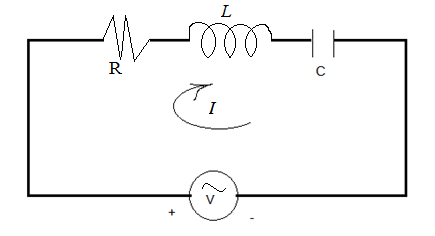
Answer
432.9k+ views
Hint: Here, in the question, we need to define and explain the Kirchhoff’s law. Kirchhoff’s law is divided into two sub-parts, i.e., Kirchhoff’s current law and Kirchhoff’s voltage law. We will limit our discussion here to Kirchhoff's voltage law only.
Complete step by step answer:
According to Kirchhoff’s voltage law, the algebraic sum of the voltage drop across all the elements in a closed circuit equals to zero. In other words, Kirchhoff's law is the conservation of energy in a closed circuit. Mathematically $\sum V = 0$.
Let us take an example to better understand the topic.
Consider a closed circuit such that a resistor of resistance R, an inductor of inductance L, and a capacitor of capacitance C are connected in series across an AC voltage source, V. Also, consider a current I flowing in the closed circuit.

In the shown figure, let us apply the Kirchhoff’s voltage rule as:
$
V - {V_R} - {V_L} - {V_C} = 0 \\
\Rightarrow V - IR - L\dfrac{{dI}}{{dt}} - \dfrac{1}{C}\int {Idt} = 0 \\
\Rightarrow V = IR + L\dfrac{{dI}}{{dt}} + \dfrac{1}{C}\int {Idt} \\
$
Hence, we can see that the energy remains conserved in the given circuit.
Note:
It is interesting to note here that the full name of Kirchhoff’s voltage law is Gustav Kirchhoff’s Voltage Law, in which Gustav Kirchhoff is the name of the scientist who discovered this law. Moreover, it is advised to the students to be aware while using the current sign convention and it varies from person-to-person.
Complete step by step answer:
According to Kirchhoff’s voltage law, the algebraic sum of the voltage drop across all the elements in a closed circuit equals to zero. In other words, Kirchhoff's law is the conservation of energy in a closed circuit. Mathematically $\sum V = 0$.
Let us take an example to better understand the topic.
Consider a closed circuit such that a resistor of resistance R, an inductor of inductance L, and a capacitor of capacitance C are connected in series across an AC voltage source, V. Also, consider a current I flowing in the closed circuit.

In the shown figure, let us apply the Kirchhoff’s voltage rule as:
$
V - {V_R} - {V_L} - {V_C} = 0 \\
\Rightarrow V - IR - L\dfrac{{dI}}{{dt}} - \dfrac{1}{C}\int {Idt} = 0 \\
\Rightarrow V = IR + L\dfrac{{dI}}{{dt}} + \dfrac{1}{C}\int {Idt} \\
$
Hence, we can see that the energy remains conserved in the given circuit.
Note:
It is interesting to note here that the full name of Kirchhoff’s voltage law is Gustav Kirchhoff’s Voltage Law, in which Gustav Kirchhoff is the name of the scientist who discovered this law. Moreover, it is advised to the students to be aware while using the current sign convention and it varies from person-to-person.
Recently Updated Pages
How many sigma and pi bonds are present in HCequiv class 11 chemistry CBSE

Mark and label the given geoinformation on the outline class 11 social science CBSE

When people say No pun intended what does that mea class 8 english CBSE

Name the states which share their boundary with Indias class 9 social science CBSE

Give an account of the Northern Plains of India class 9 social science CBSE

Change the following sentences into negative and interrogative class 10 english CBSE

Trending doubts
Difference between Prokaryotic cell and Eukaryotic class 11 biology CBSE

Which are the Top 10 Largest Countries of the World?

Differentiate between homogeneous and heterogeneous class 12 chemistry CBSE

Fill the blanks with the suitable prepositions 1 The class 9 english CBSE

Difference Between Plant Cell and Animal Cell

Give 10 examples for herbs , shrubs , climbers , creepers

The Equation xxx + 2 is Satisfied when x is Equal to Class 10 Maths

Write a letter to the principal requesting him to grant class 10 english CBSE

Change the following sentences into negative and interrogative class 10 english CBSE



